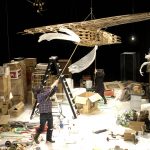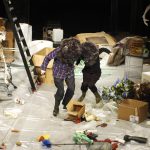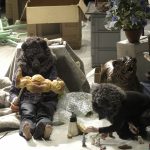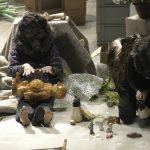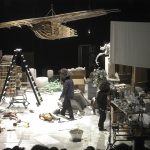

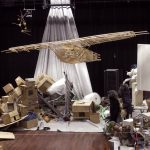
- Premiere Year 2007
Following productions that took world wars as their theme, Hotel Modern turns their attention to two more cheerful subjects: sex and curiosity. Rococo is a declaration of love to fantasy and the power of imagination. What happens when lust and curiosity are given free rein?
Hotel Modern makes a rubbish tip in the theatre, where dancing bears provide an answer to this question. Rococo is a surreal performance with dancing bears, living skeletons and bizarre miniature porn movies, created live with puppets and finger-camera's.
"The new production appears to be a radical break away from the performances based on scale models. In Rococo we again see Herman Helle and Pauline Kalker hurrying about, dealing with objects on stage, but this time they find themselves right among them. Dressed as bears they rummage around in a load of rubbish, much of which bulges from cardboard boxes." (Vrij Nederland)
"The piece is brimming with Freudian references. This imaginative representation of a world without social conventions, in which sensual impulses are given free rein, is simultaneously confrontational and funny." (Volkskrant)
"Rococo is about wonderment. The initial impression is of a light-hearted piece. But the scene at the end with the two figures onstage roasting feet over an imitation fire raises questions about the world that they, and we, live in." (Urban Mag)
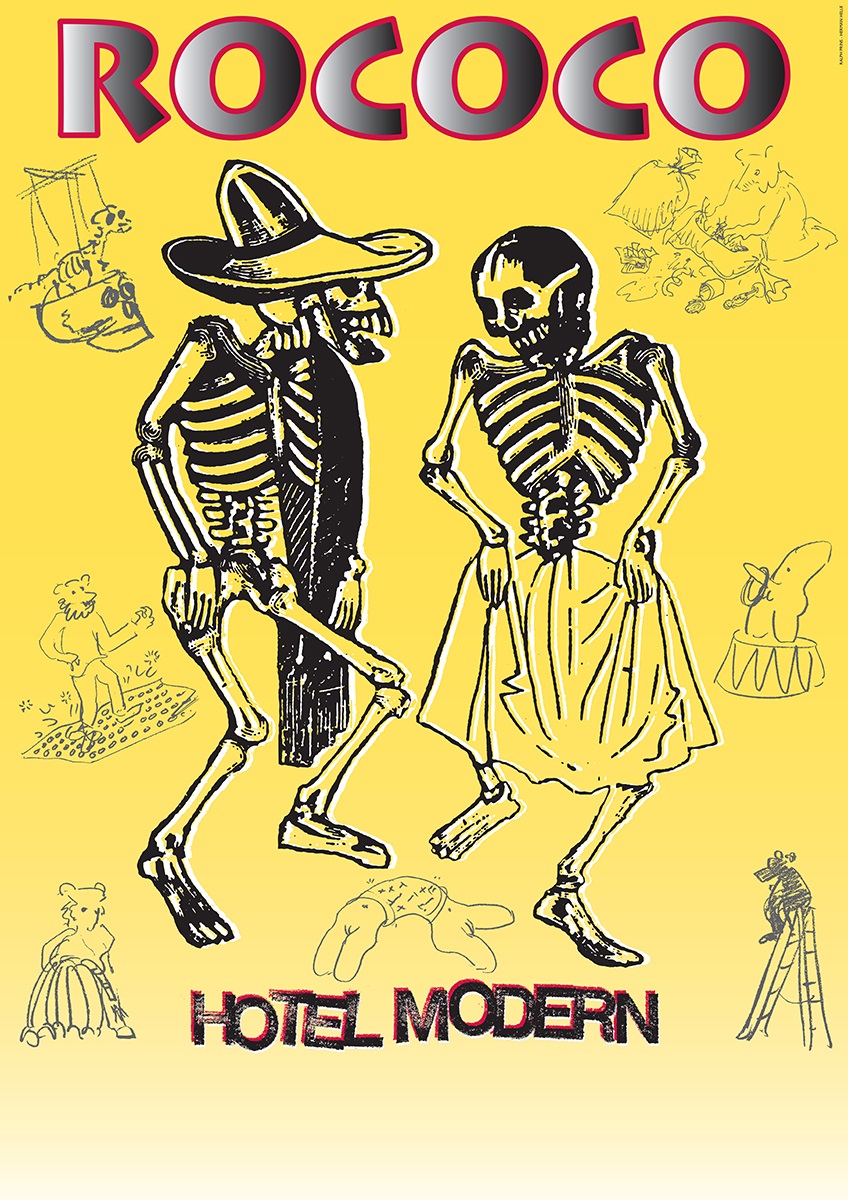
-
Reviews & articles
-
Child’s Play
The initial impression is of a light-hearted piece. But the scene at the end with the two figures onstage roasting feet over an imitation fire raises questions about the world that they, and we, live in.
by Tom Bruynooghe, Urban Mag Read the whole review
Two human-like beings interact very playfully with the objects they encounter onstage. In Rococo, we see two actors (Herman Helle and Pauline Kalker) playing. Truly playing: sometimes they are childlike; sometimes a little grotesque; and sometimes subdued. For the most part, the actors also create the sound – as they play. Like by riding over bubble wrap, or jumping up and down on it, or drilling into it. In short, then: by playing.
Rococo is about wonderment. The initial impression is of a light-hearted piece. But the scene at the end with the two figures onstage roasting feet over an imitation fire raises questions about the world that they, and we, live in.
23-08-2008
-
If you go down to the woods today… (article)
The new production appears to be a radical break away from these performances based on scale models. In Rococo we again see Herman Helle and Pauline Kalker hurrying about, dealing with objects on stage, but this time they find themselves right among them. Dressed as bears they rummage around in a load of rubbish, much of which bulges from cardboard boxes.
by Marijn van der Jagt, Vrij Nederland Read More
Rococo, the light-hearted production by Hotel Modern, appears to be a radical shift from previous performances/screenings in which they used scale models to portray the evil humans can do.
The bear on the stage is lying on his back, on a cart. He is holding up a tube several metres long, at crotch-level. It is made of grey insulating sponge; it bends a little. Slowly, the bear wheels himself among the objects on the stage. Using the end of his wobbly grey trunk he inspects the head of a large stone dog. And then, just as the grinning audience expects it to, the trunk finds the hole that is the dogs open mouth and starts to move in and out.
Hotel Modern announced beforehand that their new performance Rococo would be about sex. And those who know even a little about this Rotterdam-based theatre group know that this combination would not produce run-of-the-mill imagery. The group – Herman Helle, Arlène Hoornweg and Pauline Kalker – have built their reputation with exceptional performances blending visual art, theatre and film. Their speciality is a form of animation produced in situ in their self-made scale-model scenery and projected on a screen. The scale models represent landscapes or densely populated metropoles, and the performers move above and among them like giants. Using miniature cameras they record the scenes they have themselves created. And thus a fascinating duality is brought into being: one sees not only the magnified filmed scenes on a large screen, but also the actors who are creating those images, who dominate these landscapes and cities like gods.
Hotel Modern first broke through to larger audiences using this ‘live animation’ technique seven years ago, with The Great War. The performers had soldiers’ boots tramping around in trays of mud, among parsley-sprig trees that they set alight with Bunsen burners. One could take pleasure in observing the violent creativeness with which the actors ran amuck among their scale models. But to watch the screen was to share the sense of fear and oppressiveness felt by a soldier in the trenches. Mass slaughters were played out with toy soldiers. One particularly breathtaking and compelling image was that of a mound of corpses, which the actors – using deceptively simple methods – showed changing over passing seasons. Snow fell on the mound, spring brought greenery among the bodies, and before one’s very eyes one saw the bodies absorbed into the landscape. This ability to depict an event that actually exceeds the imagination is what has characterised and occupied Hotel Modern since making The Great War. In The Man with Five Fingers we experienced together the attack on the World Trade Centre – filmed in a milk-carton metropolis inhabited by faceless clay figures. For another performance, Kamp, the Rotterdammers constructed a scale model of Auschwitz and orchestrated the movements of clusters of puppet-prisoners among the barracks to their final destination: the ovens. Hotel Modern handled these atrocities without sentimentality and without comment, but with merciless precision. The events were at Reduced to tangible proportions in an attempt to comprehend and perhaps even process them.
Enthusiastic coïtus
The new production appears to be a radical break away from these performances based on scale models. In Rococo we again see Herman Helle and Pauline Kalker hurrying about, dealing with objects on stage, but this time they find themselves right among them. Dressed as bears they rummage around in a load of rubbish, much of which bulges from cardboard boxes. There are one or two of those wonderful live animation films in the performance – executed by the two bears – but the main emphasis is not on manipulating and organising. The bears play with the rubbish. Packaging materials, rejected household objects, plastic body parts from shop-window dummies and damaged kitsch statuettes: all are nuzzled by the bears, felt by them, and tested for various properties. The performance has a naive quality: although the bears have large and hairy heads, their bodies are relatively small human forms – they could easily have escaped from some children’s story.With cheerful curiosity they transform the rubbish tip into a playground. Although this frequently leads to rather obscene acts (sticks go into holes, a male member is fumblingly pulled into view and an attempt is made to turn it with a spanner) it does nothing to diminish their childlike bearing. Sexual acts are all part of a journey of discovery, and thus maintain a certain innocence. Using broken kitsch statuettes and clay phalluses and vaginas the bears create their own cheerful version of a sex film: while two perfectly matched body parts join in enthusiastic coitus, through the camera a statuette of a haughty rococo princess attempts to catch the eye of the snickering theatre audience.
Labour-intensive porn
Reviews were mixed – Dutch daily NRC Handelsblad described it as ‘ribald’ . Rococo might seem light after performances about historical atrocities, but if one regards this playground as an extension of these tableaux of mass destruction, might it not be that these theatre makers are rediscovering the human imagination?‘After Kamp there was so much demand for The Great War that we performed it for an extra year,’ says Herman Helle. ‘That suited us just fine because at the time we weren’t quite sure what to make next. For several years we had focused on what other people had thought of. We wanted to be more actively imaginative, but everything we tried seemed superficial after those heavy subjects. We were faced by the same question philosophers and artists have been posing since the Second World War: is poetry possible after Auschwitz?’ The idea to perform as bears offered an escape route: ‘It doesn’t matter what you do as a person on stage, it gains significance. But a bear is somehow mysterious.’
They arrived at the idea of making their own porn movies at a house music party in Rotterdam where hardcore films were projected on the walls. Helle thought the images cheap and lacking in inspiration, and there and then he came up with the idea of how much more fun it would be to make animated puppets perform the same actions. ‘But then in a more loving way; in a caring and labour-intensive way.’
In fact Rococo is not so much different from what Hotel Modern made previously. The group has always created absurdist tableaux, it is just that for the last few years they have focused on grim historical truth. It is not without reason that the Dada movement is a great source of inspiration for the Rotterdammers. Dadaist absurdism commented on the real world, turned it upside down. Despite the playfulness of this performance, on closer inspection, the bears in Rococo are set on a disquieting examination of human nature. The bears not only discover the sexual properties of all manner of materials, they also turn out to be inventors who progress at breakneck speed from prehistory to the technological age. They discover how to set things in motion, they knock up UFO-like objects that they then make ascend, and the enormous wooden aeroplane of their own design that hangs above the rubbish tip throughout the performance seems to portend everything human ingenuity has yet to provide. Both good and evil.
16-02-2008
-
A world without social conventions
The piece is brimming with Freudian references. This imaginative representation of a world without social conventions, in which sensual impulses are given free rein, is simultaneously confrontational and funny.
by Vincent Kouters, Volkskrant Read the whole review
The stage set is itself a work of art. For their latest performance, Rococo, Hotel Modern has transformed the Studio on the top floor of the Rotterdamse Schouwburg into an enormous junk room. There are old pieces of furniture, a heap of tools, leftover building materials and old clothes. Boxes that onze contained large electronic goods are stacked high and appear to be filled with yet more refuse: plastic skulls, for example, paint rollers and a remarkable number of plungers. Among all of these there are also stand tables with figurines and puppets.
Hotel Modern has become well known for performances in which they explore a particular theme and depict it with the help of miniature cameras and a stage floor filled with puppets, figurines and scale models. Inanimate objects are miraculously brought to life on a projection screen. In this way they enacted scenes from the two world wars in The Great War and Kamp. Rococo, though, is a theatrical investigation into curiosity and lust in which the scale models play only a supporting role. Among the mounds of debris on the stage floor there are two real performers – Pauline Kalker and Herman Helle. Each wearing a bear mask. Just why these two apparently primitive creatures have ended up in this disorderly place, but evidently they’ve just arrived. They quickly begin to explore this new world and turn it to their own ends. Objects are investigated and used in strange games. An obsessive curiosity takes hold of them. Boxes are pulled open and emptied out. Sink plungers and insulating material are used to make little figures. Boots are filled with water. Within an hour they work their way through the entire mess. They turn the junk room, which at first still had some degree of order, into a disgusting garbage tip.
The uninhibited way they treat everything is rendolant of children at play. Their naive way of dropping things when they’re finished with them re-enforces this impression. Unembarrassed, they make plastic skulls french kiss each other, stimulate puppets with huge erections (again with the finger camera) and play for a long time with a turd one of them has freshly produced.
The piece is brimming with these Freudian references. This imaginative representation of a world without social conventions, in which sensual impulses are given free rein, is simultaneously confrontational and funny. That there is another side to the unbridled human desire so vividly depicted in Rococo becomes apparent in the final image: we see the two figures in a kind of sad post-apocalyptic world. Everything has been used up and turned into rubbish. All that remains is survival.
24-12-2007
-
Tourdates Rococo
- View all our tourdates in the agenda
-
Makers
-
Makers and performers Pauline Kalker, Arlène Hoornweg, Herman Helle Music and sound concept Arthur Sauer Masks Kirsten Hutschemakers, Wim Groen Foam objects Barbara Witteveen Production assistant Heleen Wiemer Set assistant Stefan Gross Light design Jan Joris Lamers Technicians Joris van Oosterhout, Saskia de Vries Poster and flyer design Ralph Prins Illustrations Herman Helle Subsidy Performing Arts Fund NL, City of Rotterdam




